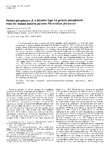Protein phosphatase beta, a putative type-2A protein phosphatase from the human malaria parasite Plasmodium falciparum.
| dc.contributor.author | Li, JL | en |
| dc.contributor.author | Baker, DA | en |
| dc.date.accessioned | 2017-11-27T18:51:25Z | |
| dc.date.available | 2017-11-27T18:51:25Z | |
| dc.date.issued | 1997-10-01 | en |
| dc.identifier.issn | 0014-2956 | en |
| dc.identifier.uri | http://hdl.handle.net/10026.1/10328 | |
| dc.description.abstract |
Protein phosphatases play a critical role in the regulation of the eukaryotic cell cycle and signal transduction. A putative protein serine/threonine phosphatase gene has been isolated from the human malaria parasite Plasmodium falciparum. The gene has an unusual intron that contains four repeats of 32 nucleotides and displays a high degree of size polymorphism among different strains of P. falciparum. The open reading frame reconstituted by removal of the intron encodes a protein of 466 amino acids with a predicted molecular mass of approximately 53.7 kDa. The encoded protein, termed protein phosphatase beta (PP-beta), is composed of two distinct domains. The C-terminal domain comprises 315 amino acids and exhibits a striking similarity to the catalytic subunits of the type-2A protein phosphatases. Database searches revealed that the catalytic domain has the highest similarity to Schizosaccharomyces pombe Ppa1 (58% identity and 73% similarity). However, it contains a hydrophilic insert consisting of five amino acids. The N-terminal domain comprises 151 amino acid residues and exhibits several striking features, including high levels of charged amino acids and asparagine, and multiple consensus phosphorylation sites for a number of protein kinases. An overall structural comparison of PP-beta with other members of the protein phosphatase 2A group revealed that PP-beta is more closely related to Saccharomyces cerevisiae PPH22. Southern blots of genomic DNA digests and chromosomal separations showed that PP-beta is a single-copy gene and is located on chromosome 9. A 2800-nucleotide transcript of this gene is expressed specifically in the sexual erythrocytic stage (gametocytes). The results indicate that PP-beta may be involved in sexual stage development. | en |
| dc.format.extent | 98 - 106 | en |
| dc.language | eng | en |
| dc.language.iso | eng | en |
| dc.subject | Amino Acid Sequence | en |
| dc.subject | Animals | en |
| dc.subject | Base Sequence | en |
| dc.subject | DNA Primers | en |
| dc.subject | DNA, Protozoan | en |
| dc.subject | Erythrocytes | en |
| dc.subject | Gene Expression Regulation, Developmental | en |
| dc.subject | Genes, Protozoan | en |
| dc.subject | Humans | en |
| dc.subject | Introns | en |
| dc.subject | Malaria, Falciparum | en |
| dc.subject | Molecular Sequence Data | en |
| dc.subject | Phosphoprotein Phosphatases | en |
| dc.subject | Plasmodium falciparum | en |
| dc.subject | Polymerase Chain Reaction | en |
| dc.subject | Protein Phosphatase 2 | en |
| dc.subject | Restriction Mapping | en |
| dc.subject | Saccharomyces cerevisiae | en |
| dc.subject | Sequence Homology, Amino Acid | en |
| dc.title | Protein phosphatase beta, a putative type-2A protein phosphatase from the human malaria parasite Plasmodium falciparum. | en |
| dc.type | Journal Article | |
| plymouth.author-url | https://www.ncbi.nlm.nih.gov/pubmed/9363759 | en |
| plymouth.issue | 1 | en |
| plymouth.volume | 249 | en |
| plymouth.publication-status | Published | en |
| plymouth.journal | Eur J Biochem | en |
| dc.identifier.doi | 10.1111/j.1432-1033.1997.t01-2-00098.x | en |
| plymouth.organisational-group | /Plymouth | |
| plymouth.organisational-group | /Plymouth/REF 2021 Researchers by UoA | |
| plymouth.organisational-group | /Plymouth/REF 2021 Researchers by UoA/UoA01 Clinical Medicine | |
| plymouth.organisational-group | /Plymouth/REF 2021 Researchers by UoA/UoA01 Clinical Medicine/UoA01 Clinical Medicine | |
| dc.publisher.place | England | en |
| dc.rights.embargoperiod | Not known | en |
| rioxxterms.versionofrecord | 10.1111/j.1432-1033.1997.t01-2-00098.x | en |
| rioxxterms.licenseref.uri | http://www.rioxx.net/licenses/all-rights-reserved | en |
| rioxxterms.type | Journal Article/Review | en |


